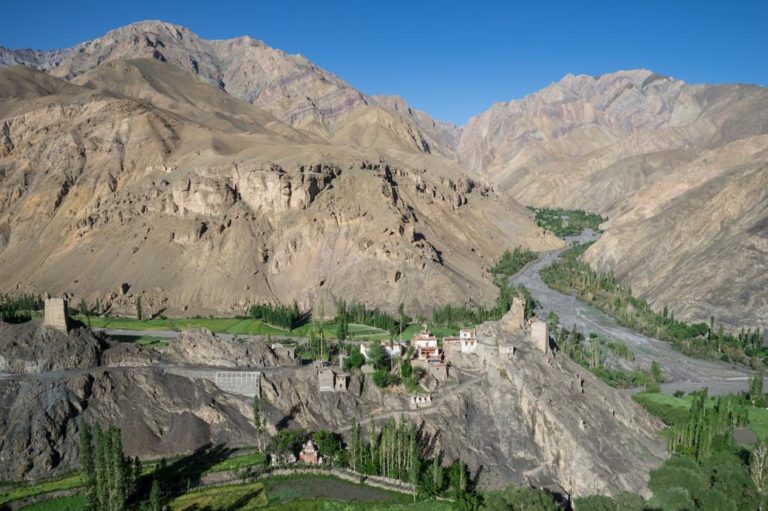
The Tashi Sumtsek (painted in white and red)
within the old fort of Wanla

The principal faces of Avalokiteśvara with eleven
heads and 1000 arms, left niche of the Tashi Sumtsek
of Wanla, first half of the 14th c.
Video conference on Zoom by Nils Martin (Doctoral student EPHE/PSL).
Already in 2002, Christian Luczanits underlined the interest of the Tashi Sumtsek, or “auspicious three-level temple”, of Wanla, Ladakh (India), for the history of Tibetan art. Founded probably in the first half of the 14th century by a powerful local leader sympathetic to the Tibetan Buddhist order Drikung Kagyu, the Tashi Sumtsek indeed contains large sets of original sculptures and murals, in addition to an inscription of foundation illuminating the history of the region. Compared to the older monuments of the “Alchi Group”, decorated in a Kashmiri style, it marks the new influence of styles in vogue in central Tibet, as well as the promotion of more esoteric teachings. Moreover, its murals are reminiscent of those of at least six other monuments in Ladakh with which the Tashi Sumtsek forms what I call the “Wanla group”.
Since 2002, new studies have deepened our knowledge of Tashi Sumtsek. In this lecture, I will present the main results of my doctoral research on the “Wanla groupâ€. We will first explore the different sets of wall paintings within the Tashi Sumtsek, seeking to establish their relative chronology. Then, we will look at the links, or rather the agents, which connect the Tashi Sumtsek to the other monuments of the “Wanla group”. Finally, we will return to the historical context, until now little known, which allowed their foundation.
VIDEO CONFERENCE on Zoom at 6pm
Topic: SEECHAC conférence de Nils Martin
Time: Mar 23, 2021 06:00 PM Paris
https://us02web.zoom.us/j/84215421759?pwd=eTJZOW1mY3VpZU5DQVUwUjdpZ2doZz09
Meeting ID: 842 1542 1759
Passcode: 3p5jxL

